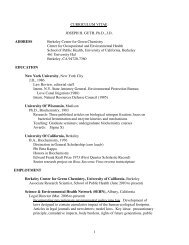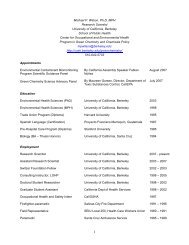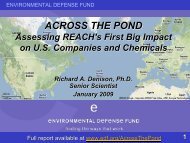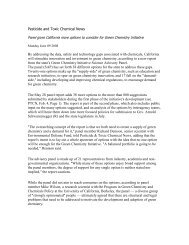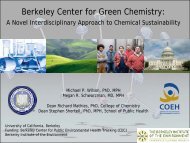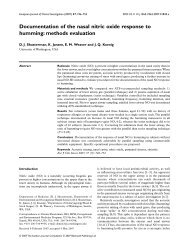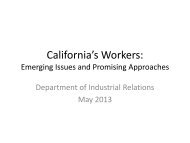Cornerstone Report Slideshow - Center for Occupational and ...
Cornerstone Report Slideshow - Center for Occupational and ...
Cornerstone Report Slideshow - Center for Occupational and ...
- No tags were found...
You also want an ePaper? Increase the reach of your titles
YUMPU automatically turns print PDFs into web optimized ePapers that Google loves.
Addressing Policy Barriers toGreen ChemistryMichael P. Wilson, PhD, MPHMegan R. Schwarzman, MD, MPHProgram in Green Chemistry & Chemicals PolicyUC Berkeley School of Public Health – <strong>Center</strong> <strong>for</strong> <strong>Occupational</strong> & Environmental Health
University of Cali<strong>for</strong>nia, Berkeley
University of Cali<strong>for</strong>nia, BerkeleyHexane-induced peripheral neuropathy in the Cali<strong>for</strong>niavehicle repair industry.
Serial Phase-Outs & Substitutions1970: Stoddard solvent Fire hazard1978: CFCs Ozone depletion1980: Methylene chloride Carcinogen1985: 1,1,1-Trichloroethane Ozone depletion1990: Perchloroethylene Dioxin emissions2002: Hexane/acetone blends NeurotoxinNext: 1-BromopropaneReproductive toxin
35 Chemicals Bills in Cali<strong>for</strong>nia, 2005-2006AB 121 (Vargas)AB 263 (Chan)AB 289 (Chan)AB 319 (Chan)AB 342 (Baca)AB 597 (Montanez)AB 623 (Aanistad)AB 639 (Aghazarian)AB 752 (Karnette)AB 815 (Lieber)AB 816 (Lieber)AB 848 (Berg)AB 908 (Chu)AB 912 (Ridley-Thomas)AB 966 (Saldana)AB 985 (Dunn)AB 990 (Lieber)AB 1125 (Pavley)AB 1337 (Ruskin)AB 1342 (Assem ESTM)AB 1344 (Assem ESTM)AB 1354 (Baca)AB 1415 (Pavley)AB 1681 (Pavley)SB 419 (Simitian)SB 432 (Simitian)SB 484 (Migden)SB 490 (Lowenthal)SB 600 (Ortiz)SB 838 (Escutia)SB 849 (Escutia)SB 982 (Sen EQ comm)SB 989 (Sen EQ comm.)SB 1067 (Kehoe)SB 1070 (Kehoe)
2006: Legislature to SPH_______________________Green Chemistry in Cali<strong>for</strong>nia:A Framework <strong>for</strong> Leadership inChemicals Policy <strong>and</strong> Innovation.2008: Cali<strong>for</strong>nia EPA to SPH_________________________Green Chemistry: <strong>Cornerstone</strong> to aSustainable Cali<strong>for</strong>nia127 UC faculty signatories from seven campuses.
The design of chemical products <strong>and</strong> processes toreduce or eliminate substances hazardous tohuman health <strong>and</strong> the environment.1. Make safer products2. Use less-toxic feedstocks <strong>and</strong> processes3. Design <strong>for</strong> cradle-to-cradle use4. Account <strong>for</strong> energy efficiencyAnastas, P.T. <strong>and</strong> J. Warner. 1999. Green Chemistry Theory <strong>and</strong> Practice
Green Chemistry:Addressing the Source
Policy Barriers to Green ChemistryDATA GAP(In<strong>for</strong>mation)SAFETYGAP(Accountability)TECHNOLOGY GAP(Capacity)
Data Gap:Business <strong>and</strong> Consumer Choice• Necessary In<strong>for</strong>mation:• Current U.S. market:FunctionPricePer<strong>for</strong>manceHazards
Data Gap:State Governments’ Ability toPrioritize Risks• Necessary In<strong>for</strong>mation:• Available In<strong>for</strong>mation:IdentitySales volumeUsesHazards
Policy Barriers to Green ChemistryDATA GAP(In<strong>for</strong>mation)SAFETYGAP(Accountability)TECHNOLOGY GAP(Capacity)
Safety Gap: TSCA’s Logical ParalysisDefinitive evidence ofcause-<strong>and</strong>-effectSt<strong>and</strong>ard of evidencerequired <strong>for</strong> regulationBalance of the evidenceReasonable grounds <strong>for</strong>concernDegree of certaintypossible based onin<strong>for</strong>mation currentlyavailable to EPAScientific suspicion ofrisk
Policy Barriers to Green ChemistryDATA GAP(In<strong>for</strong>mation)SAFETYGAP(Accountability)TECHNOLOGY GAP(Capacity)
Technology Gap:Intellectual <strong>and</strong> technical capacity tosupport green chemistryChemistry education lacks• Toxicology• Exposure• Principles of green chemistryProducers lack• Metrics <strong>for</strong> continuous improvement• Assistance with commercialization
Entrepreneurs& VCChemicalProducersDownstreamBusinessesState & LocalGovernmentsChemicals PolicyStakeholdersConsumersEnvironmentalJusticeEnvironmentalGroupsPublic HealthLabor
• Total daily Cali<strong>for</strong>nia sales of chemical products alone:644 million pounds (2,700 tankers)• Total daily U.S. chemical production <strong>and</strong> importation:42 billion pounds (623,000 tankers)Source: TSCA IUR <strong>and</strong> CA Air Resources Board
Global Chemical ProductionGrowing 3% per yearDoubling every 25 years
European Union Affecting Global ChangeREACH: Registration, Evaluation, Authorization, <strong>and</strong>Restriction of Chemicals• Data generation <strong>and</strong> disclosure to government, public<strong>and</strong> through supply chains• Management of chemicals of concern• Global effects: applies equally to European <strong>and</strong> <strong>for</strong>eignproducers <strong>and</strong> importers
REACH vs. TSCA• Data disclosure <strong>for</strong> 30,000 chemicals• Reversal of burden of proof: “no data, no market”• Level playing field <strong>for</strong> new <strong>and</strong> existing chemicals• Public access to in<strong>for</strong>mation• Two-way communication in supply chain• Substances in products• Authorization of substances of high concern
State &FederalLegislationEU: REACHBiomonitoringDataExp<strong>and</strong>ingGlobalProductionDrivers of GreenChemistryEcosystemHarmRegrettableSubstitutionsProduct SafetyProduct &HazardousWaste<strong>Occupational</strong>Disease
Product WasteGraphic arts courtesy of Chris Jordan -- chrisjordan.com
Two million plastic bottles discarded every 5 seconds in the U.S.
Plastic Contamination: the Pacific Gyre• 90% floating debris in oceans is plastic• Plastic outweighs phytoplankton 6:1• Projected to grow 10-fold in 10 years• Plastic found in 48-86% seabirds & marine mammals
426,000 cell phones retired each day in the U.S.
Global Transport of HazardsTransport of electronic waste to ChinaBasel Action Network
<strong>Occupational</strong> DiseaseCali<strong>for</strong>nia, 2004Source: Leigh et al. in preparation
Hazardous waste• 61 of 85 of CA largest hazardous waste sites leaking into groundwater• 94% pose “a major threat to human health or the environment.”• US EPA estimates 600 new sites needed each month until 2033
Biomonitoring StudiesHundreds of synthetic chemicals in breast milk<strong>and</strong> umbilical cord bloodMercuryPolyaromatic hydrocarbonsPolybrominated dibenzodioxinsPolybrominated dibenzofuranssPerfluorinated chemicalsPolychlorinated dibenzodioxinsPolychlorinated dibenzofuransOrganochlorine pesticidesPolybrominated diphenyl ethersPolychlorinated naphthalenesPolychlorinated biphenylsPBDE Levels in Breast Milk, SwedenDarnerud et al. 2002
Perception of Product Safety
U.S. Toxic Substances Control Act (TSCA):An 82,000 Piece Jigsaw Puzzle
Green Chemistry Opportunity:Eliminating the Policy BarriersPolicy objectives• Close the data gap (In<strong>for</strong>mation)• Close the safety gap (Accountability)• Close the technology gap (Capacity)Policy strategies• Dem<strong>and</strong> side: increasing the competitive advantageof safer substances• Supply side: building capacity to meet dem<strong>and</strong>
Policy with Environmental & Economic AimsPer Capita Electricity Consumption, 1960-2007Source: Cali<strong>for</strong>nia Energy Commission, 2007
University of Cali<strong>for</strong>nia, BerkeleyProgram in Green Chemistry& Chemicals Policyhttp://coeh.berkeley.edu/greenchemistryUC Berkeley School of Public Health<strong>Center</strong> <strong>for</strong> <strong>Occupational</strong> &Environmental Health



